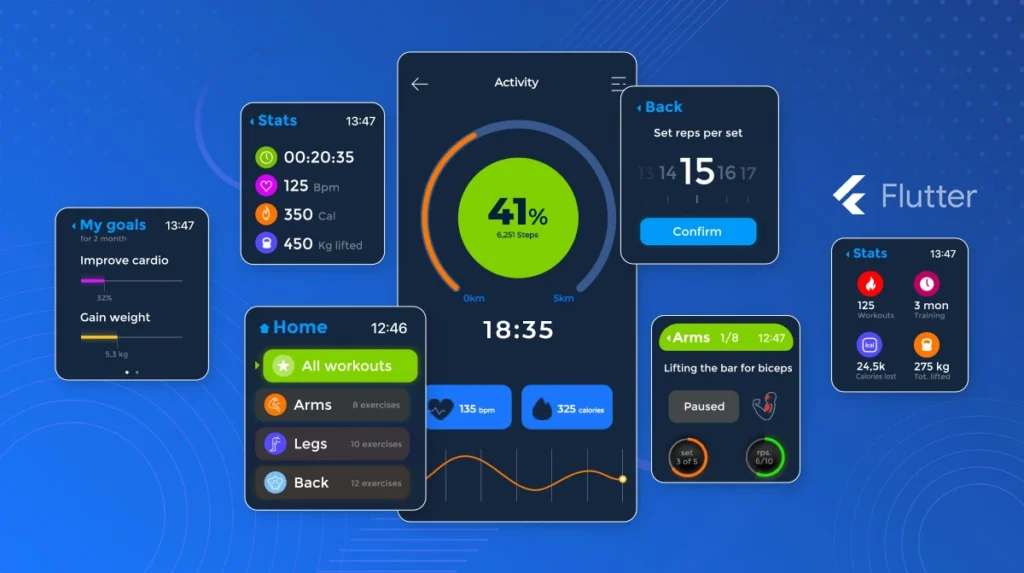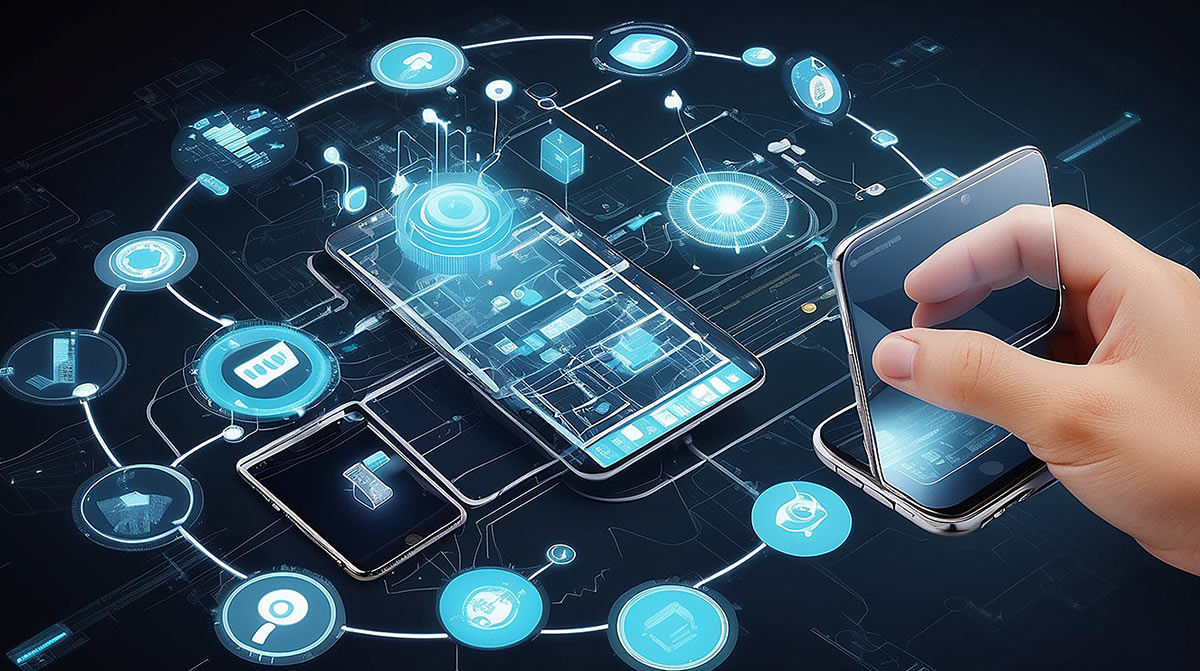The Rise of Wearable Devices and Flutter’s Role
In recent years, wearable devices such as smartwatches and fitness trackers have rapidly evolved from novel gadgets to essential tools of contemporary times. These devices go far beyond telling time or counting steps; they help monitor vital signs, communicate, and even provide entertainment options. Wearables have now integrated deeply into our daily routines, enhancing health management, connectivity, and convenience.
The increasing demand for these devices has placed unique challenges on developers. Wearables require applications that are not only lightweight and efficient but also capable of running seamlessly across multiple platforms like Android, iOS, and proprietary wearable OS systems. This is where Flutter, Google’s powerful UI toolkit, becomes a game-changer. Flutter has revolutionized the development of apps for wearables by offering a versatile, high-performance, and cross-platform framework. Let’s explore how Flutter is transforming wearable app development.
What Is Wearable App Development?
Wearable app development includes designing, creating, and deploying apps for wearable technology devices such as smartwatches, fitness bands, and smart glasses. Wearable applications are not like traditional smartphone apps. They are intended to operate on devices with limited screen area, lower battery capacity, and unique hardware characteristics and supplement the capabilities of wearable devices.
Wearable Device Market Overview
The wearable technology industry is expanding rapidly each year as hardware, software, and connections improve. According to Markets and Markets, the worldwide wearable technology market was valued at USD 116.2 billion in 2021 and is expected to reach USD 265.4 billion in 2026. This significant growth is driven by increased consumer awareness of health monitoring gadgets that may interface with other intelligent technology.
Wearable gadgets have expanded beyond simple activity trackers, including smart watches, smart glasses, and colorful clothes. Today, smartwatches account for the vast majority of wearable technology, with more than half of what is available on the market deemed ubiquitous. Smart wearable watches are more than just timepieces; they also measure health indicators, steps, heart rate, and blood pressure, make calls and send notifications, and even function as a payment system.
Entertainment, corporate productivity, and finance are a few additional areas that are aggressively embracing wearable technology, unleashing new opportunities in various industries.
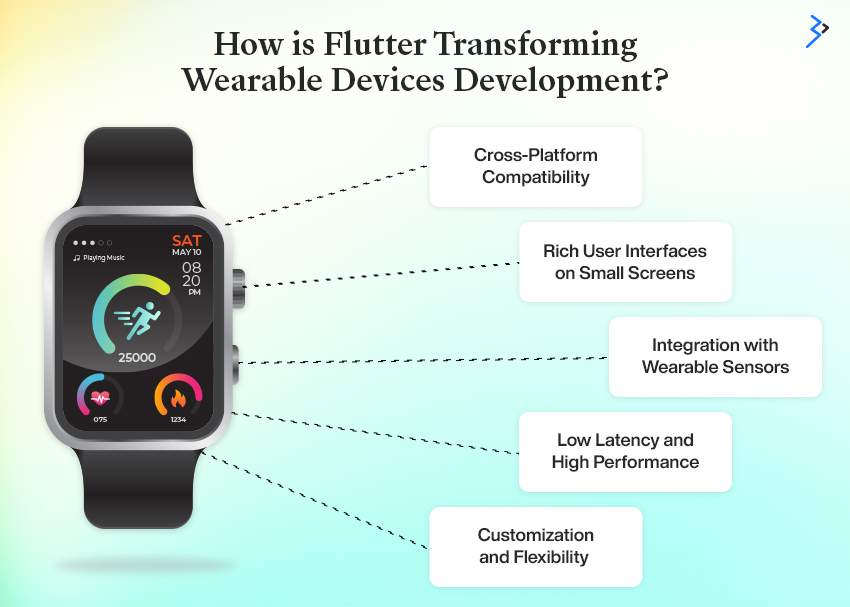
How is Flutter Transforming Wearable Devices Development?
As the popularity of wearables rises, so does the demand for smooth and easy software to power them.
Flutter is a Google UI toolkit that allows you to create natively built mobile, web, and desktop apps using a single codebase. However, its interoperability does not end there; it is also a viable platform for wearables.
Cross-Platform Compatibility
One of Flutter’s most significant advantages is its cross-platform compatibility. By allowing developers to write a single codebase for multiple platforms, Flutter ensures that apps function smoothly on Android and iOS wearables. This eliminates the need to develop separate apps for each platform, reducing development time and cost while maintaining consistency.
Rich User Interfaces on Small Screens
Flutter provides a range of customizable widgets that help create rich, visually appealing user interfaces. Wearables typically have small screens, making the design of intuitive and responsive UIs crucial. Flutter’s powerful rendering engine ensures that every interaction looks great, regardless of the screen size or resolution, allowing for detailed, interactive experiences on smartwatches and fitness trackers.

Integration with Wearable Sensors
Many wearables are equipped with sensors like heart rate monitors, GPS, and accelerometers. Flutter easily integrates with these sensors, enabling real-time tracking and personalized user experiences. Whether fitness apps measure steps or health apps monitor heart rates, Flutter provides seamless sensor integration to maximize the potential of wearable devices.
Low Latency and High Performance
Flutter’s ability to compile directly to native ARM code results in low latency and smooth performance, which are critical for wearables. High performance is non-negotiable as wearables often operate in real-time (e.g., fitness tracking during a workout). Flutter ensures that apps run with minimal delays, offering users a highly responsive and engaging experience.
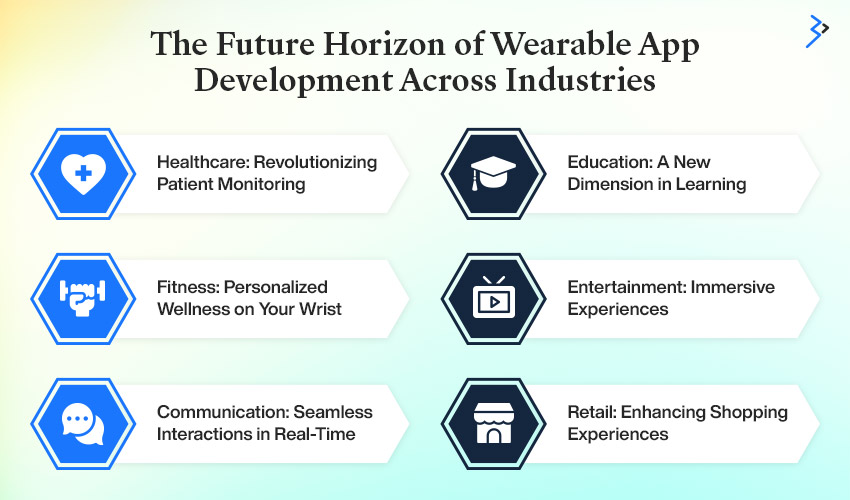
The Future Horizon of Wearable App Development Across Industries
Wearable devices are no longer confined to fitness and health. The future holds vast potential for their expansion into multiple industries, transforming how we interact with technology.
Healthcare: Revolutionizing Patient Monitoring
The healthcare industry is the largest adopter of wearable technology, driving innovation in patient monitoring, diagnostics, and treatment. Wearables in healthcare now track everything from sleep patterns to blood oxygen levels, empowering patients and medical professionals with real-time data. By 2030, the global wearable medical devices market is projected to reach $428.92 billion at a CAGR of 28.6%, according to Fortune Business Insight. Flutter enables developers to build reliable, cross-platform healthcare apps that integrate with medical-grade sensors, pushing the boundaries of remote patient monitoring.
Education: A New Dimension in Learning
Wearable technology revolutionizes education by providing students with immersive, hands-on learning experiences. Virtual reality headsets powered by Flutter allow medical students to practice surgery simulations or engineering students to explore construction sites from the safety of a classroom. This technology enhances the learning process, enabling students to visualize and interact with complex concepts in ways that traditional textbooks cannot. Flutter’s flexibility and sensor integration capabilities allow the development of education apps that offer real-world simulations and immersive learning environments, propelling the future of education.
Fitness: Personalized Wellness on Your Wrist
Fitness wearables remain among the most popular applications of wearable tech, giving users control over their health and fitness goals. Fitness apps powered by wearables monitor activity levels, calories burned, and heart rates, providing personalized coaching and insights. With Flutter, developers can create apps that offer a seamless, engaging experience while tracking real-time metrics from multiple wearable sensors. As technology advances, future fitness apps may evolve to provide even more personalized health recommendations and coaching services.
Entertainment: Immersive Experiences through Wearable Tech
The entertainment industry has seen a massive boost with the integration of wearables like Apple Vision Pro, VR headsets, and smart eyewear. These devices allow users to interact with media in immersive environments, transforming how we consume entertainment. Flutter’s high-performance capabilities ensure that apps for entertainment wearables run smoothly, offering a unique blend of virtual reality (VR) and augmented reality (AR) experiences. From gaming to streaming content, wearables are enhancing the entertainment industry by creating interactive, immersive experiences that were previously unimaginable.
Communication: Seamless Interactions in Real-Time
Wearable devices enhance communication by enabling users to stay connected without constantly relying on their smartphones. Flutter-powered apps allow users to receive notifications, respond to messages, and attend virtual meetings directly from their wearables. The future of communication is immersive, as devices like VR headsets enable users to engage in virtual calls and meetings, creating more interactive and engaging remote work environments. Flutter’s ability to support multiple platforms ensures seamless integration across wearables and smartphones, making communication more accessible and efficient.
Retail: Enhancing Customer Shopping Experiences
Retailers are leveraging wearables to enhance the shopping experience. From virtual try-ons to contactless payments, wearable technology offers convenience and personalization. With Flutter, retailers can develop apps allowing customers to browse, try out products, and complete purchases through their wearable devices. Smartwatches can now facilitate quick, contactless payments while health-tracking wearables can offer personalized product recommendations based on the customer’s health data. This intersection of technology and retail provides an unparalleled customer experience.
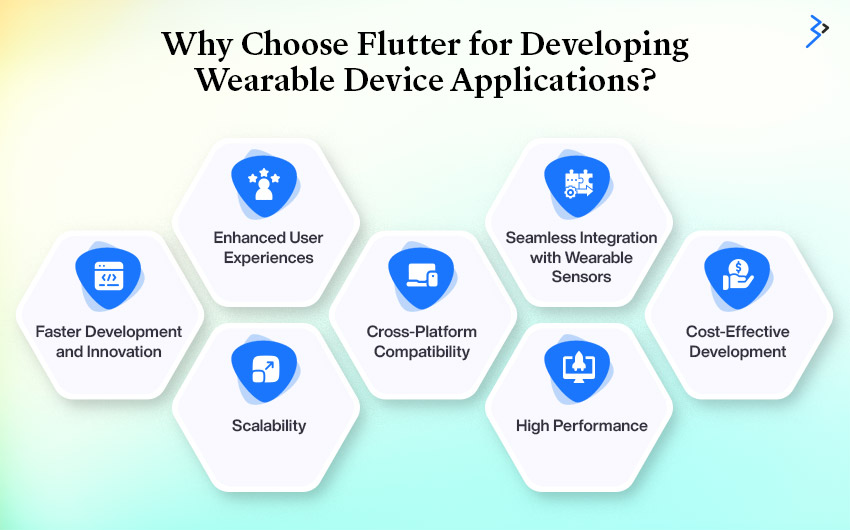
Why Choose Flutter for Developing Wearable Device Applications?
1. Faster Development and Innovation
Flutter’s single codebase accelerates the development process, allowing for faster app releases and quicker innovation. Developers can implement new features and updates more efficiently, reducing time to market and ensuring wearables keep pace with the latest technological advancements.
2. Enhanced User Experiences
Flutter is known for creating rich, interactive UIs that adapt well to smaller screens, which are essential for wearables. With a focus on customization, developers can design apps that deliver highly engaging and user-friendly experiences, whether on a smartwatch or fitness tracker.
3. Scalability
Flutter’s modular architecture supports seamless scalability. Whether your app starts with basic functionality or includes advanced features, Flutter allows you to scale your app to accommodate a growing user base or add new capabilities without overhauling the entire system.
4. Cross-Platform Compatibility
Flutter allows developers to write once and distribute to various platforms, including iOS, Android, and wearable operating systems. This saves time and costs, allowing firms to reach a larger audience.
5. Seamless Integration with Wearable Sensors
Flutter integrates effortlessly with wearable sensors such as heart rate monitors, GPS, etc. This capability ensures that wearable apps provide accurate, real-time data for fitness, healthcare, and other industry applications, enhancing user engagement and satisfaction.
6. High Performance
With native ARM code compilation, Flutter ensures high-performance apps with minimal latency, a crucial factor for real-time applications in wearable devices. This feature guarantees that apps run smoothly and efficiently, offering users a reliable experience.
7. Cost-Effective Development
The ability to develop cross-platform apps with a single codebase significantly reduces the development cost. Flutter’s efficiency in wearable app development makes it an economical solution, especially for startups or businesses looking to enter the wearable tech market.
Traditional Wearable App Development vs. Wearable App Development with Flutter
| Feature | Traditional Wearable App Development | Wearable App Development with Flutter |
| Concept | Separate codebases for each platform | Single codebase for multiple platforms |
| Pros | Native performance, deep platform integration | Cross-platform compatibility, faster development |
| Scalability | Resource-intensive scaling | Efficient scaling with one codebase |
| UI/UX Design | Platform-specific designs | Customizable widgets adapting to all platforms |
| Integration with Sensors | Platform-specific APIs | Unified sensor integration |
| Performance | High performance but time-consuming | Near-native performance with low latency |
| Maintenance | Updates across multiple codebases | Simplified maintenance with lower costs |
| Security | Vendor-specific security measures | Consistent security with community support |
Traditional development requires separate codebases for each platform, leading to native performance but at the cost of increased development time, complexity, and maintenance. On the other hand, Flutter provides a single codebase for multiple platforms, which improves development speed, simplifies maintenance, and ensures cross-platform compatibility. Flutter’s customizable widgets allow developers to create consistent and responsive user interfaces across different devices.
Traditional apps may offer native performance but often require time-consuming optimization processes. Flutter’s native ARM compilation achieves near-native performance with significantly lower latency. Traditional development relies on platform-specific APIs when integrating with sensors, while Flutter provides unified integration, streamlining sensor utilization across devices.
Traditional development can be resource-intensive regarding scalability. In contrast, Flutter ensures more efficient scaling thanks to its modular architecture. Finally, Flutter simplifies maintenance, as updates and security measures can be applied universally, leading to lower costs and faster deployment.
Wrap Up
Flutter has become the go-to solution for developers looking to create scalable, high-performance applications for wearables. Its cross-platform compatibility, rich UI toolkit, seamless sensor integration, and high performance make it the ideal choice for building next-generation wearable apps. As the demand for wearables grows, Flutter is well-positioned to be at the forefront of this technological revolution. Whether you’re building fitness trackers, healthcare monitors, or immersive VR entertainment apps, Flutter is transforming how we interact with wearable technology, offering limitless possibilities for the future.
Ready to take your wearable app development to the next level? With Flutter’s powerful toolkit, you can create innovative, high-performance apps that redefine how users interact with wearables.
FAQs on Wearable App Development with Flutter
- What technical expertise is required to develop wearable apps with Flutter?
Developers need a solid understanding of the Flutter framework and Dart language and basic knowledge of sensor integrations like GPS and heart rate monitors.
- How do I manage relationships and support across different platforms when using Flutter for wearables?
Flutter’s cross-platform capability simplifies managing support across iOS, Android, and other wearable platforms with a unified codebase.
- How do I ensure consistent performance and user experience across wearable devices with Flutter?
By using Flutter’s native ARM code compilation and its adaptive UI tools, you ensure high performance and consistent user experiences across various devices.
- How can I measure the success of my wearable app developed with Flutter?
Success metrics can include user engagement, real-time performance tracking, sensor data accuracy, user feedback, and app downloads.
Related Articles
-
Mobile Apps- The New Frontier Of Media And Entertainment Industry
The trends do not exist to stay for a longer run! Puzzled? Let’s figure out. Years back, we glued to the televisions to watch movies, latest score updates of cricket,
-
Top 5 Considerations While Selecting A Mobile Application Development Company
Mobile application development companies are numerous. It’s particularly a tedious task to locate the right one for your business. Picking just any one (amongst millions) is like gambling. All companies
-
New Android 11 Features and its Impact on Apps
The new Android 11 release might take some people by surprise with its news line of features, while for others, it will be just about an upgrade. However, there is

